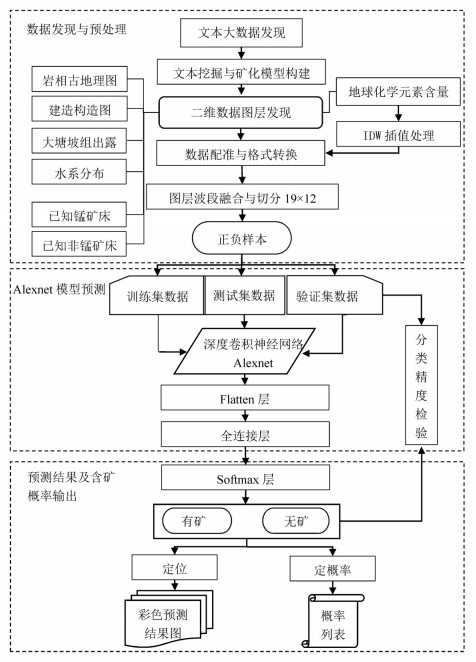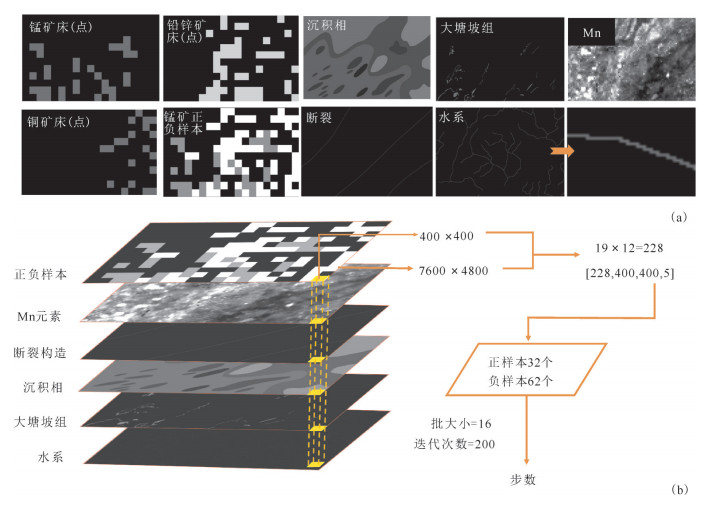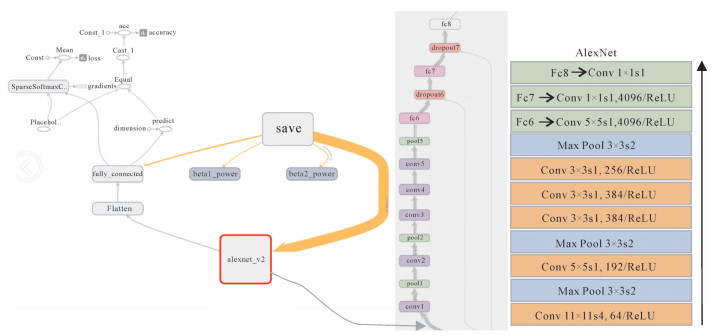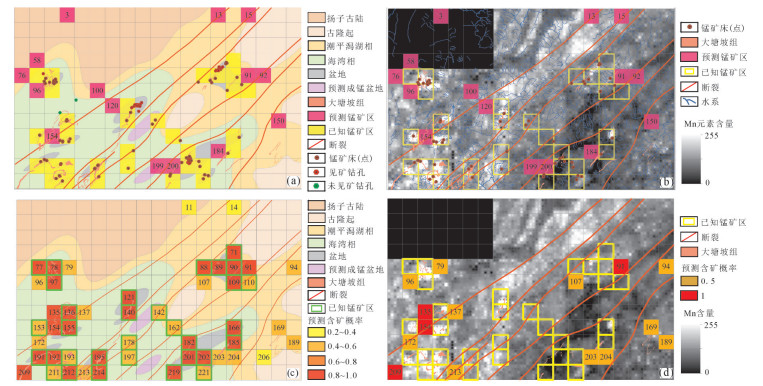Two-dimensional prospecting prediction based on AlexNet network: A case study of sedimentary Mn deposits in Songtao-Huayuan area
-
摘要:
在大数据的时代背景下,地质大数据逐渐趋于复杂化的模式与其间的空间关联性为基于机器学习算法的矿产资源定量预测带来了更大的挑战。利用深度卷积网络算法优异的分析性能来提取不同成矿条件下多种二维要素图层的空间分布特征与关联性是一项非常有意义的探索性实验。以松桃-花垣地区沉积型锰矿为例,利用深度卷积神经网络模型AlexNet挖掘Mn元素、沉积相、大塘坡组出露、断裂及水系的空间分布与锰矿矿床的就位空间的耦合相关性,以及不同的控矿要素之间的相关性,以此训练出二维矿产预测分类模型。经过训练后,可以得到验证准确率88.89%,召回率为66.67%,损失值0.08的深度卷积神经网络分类模型。应用该模型对未知区进行二维成矿预测,共圈定出91、96、154、184号4个成矿远景区,其中91号和154号的区域含矿概率为1,96号含矿概率为0.5。由此可见,预测区具有很大概率存在尚未发现的矿床。
-
关键词:
- 大数据 /
- 找矿预测 /
- 卷积神经网络 /
- Alextnet网络 /
- 松桃-花垣锰矿
Abstract:There are many challenges in the task of predicting ore deposits from big data repositories. The data are inherently complex and have great significance to the intervenient spatial relevance of deposits. The characteristics of the data make it difficult to use machine learning algorithms for the quantitative prediction of mineral resources. There are considerable interest and value in extracting spatial distribution characteristics from two-dimensional ore-controlling factors'layers under different metallogenic conditions. In this paper, the authors conducted such an analysis by using a Deep Convolutional Neural Network (D-CNN) algorithm named AlexNet. Training on the two-dimensional (2-d) mineral prediction and classification model was performed using data from the Songtao-Huayuan sedimentary manganese deposit. The authors investigated the coupling correlation between the spatial distribution of manganese element, sedimentary facies, outcrop of Datangpo Formation, faults, water system and the areas where manganese orebodies are present, as well as the correlation between different ore-controlling factors by employing the AlexNet networks. After training, the deep convolutional neural network classification model with the verification accuracy of 88.89%, recall of 66.67% and loss value of 0.08 could be obtained. By applying this model to unknown areas for two-dimensional metallogenic prediction, four metallogenic prospective areas. i.e., No. 91, No. 96, No. 154 and No. 184, were delineated, in which the ore potential probability of No. 91 regional ore-bearing probability and No. 154 prospective area is 1, and that of No. 96 is 0.5, suggesting that the probability of existence of undiscovered deposits in prediction areas is large.
-
-
表 1 松桃—花垣地区沉积型锰矿找矿模型
Table 1 Prospecting model for the sedimentary Mn deposits in Songtao–Huayuan area
预测要素 内容 成矿时代 南华纪大塘坡期 大地构造位置 张家界-花垣褶冲带 古地理 拉伸裂陷盆地 沉积相 半局限海湾含锰质页岩亚相 沉积序列 主要分布在南华纪第三层序(NHS3)和第四层序(NHS4)2个三级层序中,主要在海侵体系域(TST)和凝缩段(SS)2个体系域中 古气候 半局限海湾环境,气候转暖,为间冰期湿热气候,相应地出现消融性海侵 沉积建造 黑色页岩建造 构造 构造交会处,深大断裂和基底同生断裂 含锰岩系 黑色含粉砂质炭质页岩与条带状菱锰矿层组成,含锰岩系厚度大于35m时,锰矿体厚可达5~7m,Mn品位在24%以上(民乐);当含锰岩系厚度小于10m时,难以形成具规模的锰矿体(衫木寨) 岩层指示标志 厚层冰碛砾岩 地球化学 Mn元素异常值大于1200×10-6范围与矿化特征吻合 表 2 松桃—花垣地区含矿概率预测结果统计
Table 2 Statistics of predicted ore-bearing probability in Songtao–Huayuan area
编号 含矿 不含矿 0 0.00 1.00 1 0.00 1.00 2 0.00 1.00 3 0.00 1.00 4 0.00 1.00 5 0.00 1.00 6 0.00 1.00 7 0.00 1.00 8 0.00 1.00 9 0.00 1.00 10 0.00 1.00 11 0.23 0.77 12 0.00 1.00 13 0.01 0.99 14 0.36 0.64 15 0.00 1.00 16 0.00 1.00 17 0.00 1.00 18 0.00 1.00 19 0.00 1.00 20 0.00 1.00 21 0.00 1.00 22 0.00 1.00 23 0.00 1.00 24 0.00 1.00 25 0.00 1.00 26 0.00 1.00 27 0.00 1.00 28 0.00 1.00 29 0.00 1.00 30 0.00 1.00 31 0.00 1.00 32 0.00 1.00 33 0.00 1.00 34 0.00 1.00 35 0.00 1.00 36 0.00 1.00 37 0.00 1.00 38 0.00 1.00 39 0.00 1.00 40 0.00 1.00 41 0.00 1.00 42 0.00 1.00 43 0.00 1.00 44 0.00 1.00 45 0.00 1.00 46 0.00 1.00 47 0.00 1.00 48 0.00 1.00 49 0.00 1.00 50 0.00 1.00 51 0.00 1.00 52 0.00 1.00 53 0.00 1.00 54 0.00 1.00 55 0.00 1.00 56 0.00 1.00 57 0.00 1.00 58 0.00 1.00 59 0.00 1.00 60 0.00 1.00 61 0.00 1.00 62 0.00 1.00 63 0.00 1.00 64 0.00 1.00 65 0.00 1.00 66 0.00 1.00 67 0.00 1.00 68 0.00 1.00 69 0.00 1.00 70 0.00 1.00 71 1.00 0.00 72 0.00 1.00 73 0.00 1.00 74 0.00 1.00 75 0.00 1.00 76 0.01 0.99 77 1.00 0.00 78 1.00 0.00 79 0.50 0.50 80 0.04 0.96 81 0.00 1.00 82 0.00 1.00 83 0.00 1.00 84 0.00 1.00 85 0.00 1.00 86 0.00 1.00 87 0.00 1.00 88 1.00 0.00 89 1.00 0.00 90 1.00 0.00 91 1.00 0.00 92 0.00 1.00 93 0.00 1.00 94 0.50 0.50 95 0.00 1.00 96 0.50 0.50 97 1.00 0.00 98 0.01 0.99 99 0.00 1.00 100 0.00 1.00 101 0.03 0.97 102 0.00 1.00 103 0.00 1.00 104 0.00 1.00 105 0.00 1.00 106 0.00 1.00 107 0.50 0.50 108 0.00 1.00 109 1.00 0.00 110 0.50 0.50 111 0.00 1.00 112 0.00 1.00 113 0.00 1.00 114 0.01 0.99 115 0.01 0.99 116 0.00 1.00 117 0.00 1.00 118 0.00 1.00 119 0.00 1.00 120 0.00 1.00 121 1.00 0.00 122 0.00 1.00 123 0.00 1.00 124 0.00 1.00 125 0.00 1.00 126 0.00 1.00 127 0.00 1.00 128 0.00 1.00 129 0.00 1.00 130 0.00 1.00 131 0.00 1.00 132 0.00 1.00 133 0.00 1.00 134 0.01 0.99 135 1.00 0.00 136 1.00 0.00 137 0.50 0.50 138 0.00 1.00 139 0.00 1.00 140 1.00 0.00 141 0.00 1.00 142 0.50 0.50 143 0.00 1.00 144 0.00 1.00 145 0.00 1.00 146 0.00 1.00 147 0.00 1.00 148 0.00 1.00 149 0.01 0.99 150 0.00 1.00 151 0.00 1.00 152 0.01 0.99 153 0.50 0.50 154 1.00 0.00 155 1.00 0.00 156 0.00 1.00 157 0.00 1.00 158 0.07 0.93 159 0.00 1.00 160 0.00 1.00 161 0.00 1.00 162 0.50 0.50 163 0.00 1.00 164 0.00 1.00 165 0.00 1.00 166 1.00 0.00 167 0.00 1.00 168 0.00 1.00 169 0.50 0.50 170 0.00 1.00 171 0.00 1.00 172 0.50 0.50 173 0.00 1.00 174 0.00 1.00 175 0.00 1.00 176 0.00 1.00 177 0.00 1.00 178 0.50 0.50 179 0.00 1.00 180 0.00 1.00 181 0.00 1.00 182 1.00 0.00 183 0.00 1.00 184 0.01 0.99 185 1.00 0.00 186 0.00 1.00 187 0.01 0.99 188 0.00 1.00 189 0.50 0.50 190 0.00 1.00 191 1.00 0.00 192 1.00 0.00 193 0.50 0.50 194 0.04 0.96 195 1.00 0.00 196 0.00 1.00 197 0.50 0.50 198 0.00 1.00 199 0.00 1.00 200 0.00 1.00 201 1.00 0.00 202 1.00 0.00 203 0.50 0.50 204 0.50 0.50 205 0.00 1.00 206 0.28 0.72 207 0.00 1.00 208 0.00 1.00 209 1.00 0.00 210 0.00 1.00 211 0.50 0.50 212 1.00 0.00 213 0.50 0.50 214 1.00 0.00 215 0.00 1.00 216 0.00 1.00 217 0.00 1.00 218 0.00 1.00 219 1.00 0.00 220 0.00 1.00 221 0.50 0.50 222 0.00 1.00 223 0.00 1.00 224 0.00 1.00 225 0.00 1.00 226 0.00 1.00 227 0.00 1.00 表 3 基于AlexNet模型得分预测结果与Softmax函数归一化后预测结果对比
Table 3 Contrast between the prediction result based on the score of AlexNet model and the prediction result normalized by Softmax function
AlexNet模型得分 Softmax计算含矿概率 第一次实验 3、58、92、150、184、199 含矿概率为1 91、135、154、209 含矿概率 > 0.5 79、94、96、137、169、172、189、203、204 第二次实验 13、15、76、91、92、96、100、120、154、199、200 含矿概率 > 0 11、14、80、98、101、114、115、134、158、184、187、206 -
赵鹏大.大数据时代数字找矿与定量评价[J].地质通报, 2015, 34(7):1255-1259. doi: 10.3969/j.issn.1671-2552.2015.07.001 肖克炎, 孙莉, 李楠, 等.大数据思维下的矿产资源评价[J].地质通报, 2015, 34(7):1266-1272. doi: 10.3969/j.issn.1671-2552.2015.07.003 陈建平, 李婧, 崔宁, 等.大数据背景下地质云的构建与应用[J].地质通报, 2015, 34(7):1260-1265. doi: 10.3969/j.issn.1671-2552.2015.07.002 于萍萍, 陈建平, 柴福山等.基于地质大数据理念的模型驱动矿产资源定量预测[J].地质通报, 2015, 34(7):1333-1343. doi: 10.3969/j.issn.1671-2552.2015.07.011 郑啸, 李景朝, 王翔, 等.大数据背景下的国家地质信息服务系统建设[J].地质通报, 2015, 34(7):1316-1322. doi: 10.3969/j.issn.1671-2552.2015.07.009 Zuo R G, Xiong Y H. Big data analytics of identifying geochemical anomalies supported by machine learning methods[J]. Natural Resources Research, 2018, 27(1):5-13. doi: 10.1007/s11053-017-9357-0
Twarakavi N K C, Misra D, Bandopadhyay S. Prediction of arsenic in bedrock derived stream sediments at a gold mine site under conditions of sparse data[J]. Natural Resources Research, 2006, 15(1):15-26. doi: 10.1007/s11053-006-9013-6
Chen M, Mao S W, Liu Y H. Big data:A survey[J]. Mobile Networks and Applications, 2014, 19(2):171-209. doi: 10.1007/s11036-013-0489-0
O' Brien J J, Spry P G, Nettleton D, et al. Using Random Forests to distinguish gahnite compositions as an exploration guide to Broken Hill-type Pb-Zn-Ag deposits in the Broken Hill domain, Australia[J]. Journal of Geochemical Exploration, 2015, 149:74-86. doi: 10.1016/j.gexplo.2014.11.010
Gonbadi A M, Tabatabaei S H, Carranza E J M. Supervised geochemical anomaly detection by pattern recognition[J]. Journal of Geochemical Exploration, 2015, 157:81-91. doi: 10.1016/j.gexplo.2015.06.001
Kirkwood C, Cave M, Beamish D, et al. A machine learning approach to geochemical mapping[J]. Journal of Geochemical Exploration, 2016, 167:49-61. doi: 10.1016/j.gexplo.2016.05.003
Zhao J N, Chen S Y, Zuo R G. Identifying geochemical anomalies associated with Au-Cu mineralization using multifractal and artificial neural network models in the Ningqiang district, Shaanxi, China[J]. Journal of Geochemical Exploration, 2016, 164:54-64. doi: 10.1016/j.gexplo.2015.06.018
Xiong Y H, Zuo R G. Recognition of geochemical anomalies using a deep autoencoder network[J]. Computers & Geosciences, 2016, 86:75-82. http://www.wanfangdata.com.cn/details/detail.do?_type=perio&id=f659583bb053f79afe258c22bcc05d8a
Chen Y L, Wu W. Application of one-class support vector machine to quickly identify multivariate anomalies from geochemical exploration data[J]. Geochemistry:Exploration, Environment, Analysis, 2017, 17(3):231-238. doi: 10.1144/geochem2016-024
陈建平, 李靖, 谢帅, 等.中国地质大数据研究现状[J].地质学刊, 2017, 41(3):353-366. http://d.old.wanfangdata.com.cn/Periodical/jsdz201703001 陈三明.锡矿山锑矿田多元地学综合信息成矿预测研究[D].中国地质大学(北京)博士学位论文, 2012: 1-290. http://cdmd.cnki.com.cn/Article/CDMD-11415-1012364487.htm 陈剑平.基于MATLAB的神经网络模式识别技术在油气化探中的研究及应用[D].中国地质大学(北京)硕士学位论文, 2008: 1-49. http://cdmd.cnki.com.cn/Article/CDMD-11415-2008068717.htm 杨浩.深度学习与主成分分析融合的研究与应用[D].成都理工大学硕士学位论文, 2016: 1-41. http://cdmd.cnki.com.cn/Article/CDMD-10616-1016224928.htm Albora A M, Ucan O N, Ozmen A, et al. Separation of Bouguer anomaly map using cellular neural network[J]. Journal of Applied Geophysics, 2001, 46(2):129-142. doi: 10.1016/S0926-9851(01)00033-7
刘展, 刘茂诚, 魏巍, 等.基于细胞神经网络方法的重力异常分离[J].中国石油大学学报(自然科学版), 2010, 34(4):57-61. doi: 10.3969/j.issn.1673-5005.2010.04.010 李超, 江玉乐, 胡明科, 等.细胞神经网络在重力异常分异中的研究及应用[J].物探化探计算技术, 2015, 37(1):16-21. doi: 10.3969/j.issn.1001-1749.2015.01.03 刘艳鹏, 朱立新, 周永章.卷积神经网络及其在矿床找矿预测中的应用——以安徽省兆吉口铅锌矿床为例[J].岩石学报, 2018, 34(11):3217-3224. http://www.wanfangdata.com.cn/details/detail.do?_type=perio&id=ysxb98201811007 Krizhevsky A, Sutskever I, Hinton G E. Image Net classification with deep convolutional neural networks[C]//Inter-national Conference on Neural Information ProcessingSystems. Curran Associates Inc., 2012: 1097-1105. doi: 10.5555/2999134.2999257
周琦, 杜远生, 袁良军, 等.古天然气渗漏沉积型锰矿床找矿模型——以黔湘渝毗邻区南华纪"大塘坡式"锰矿为例[J].地质学报, 2017, 91(10):2285-2298. doi: 10.3969/j.issn.0001-5717.2017.10.010 刘巽锋, 王庆生, 高兴基, 等.贵州锰矿地质[M].贵阳:贵州人民出版社, 1989:1-191. 王砚耕, 王兴来, 朱顺才.贵州东部大塘坡组地层沉积环境和成锰作用[M].贵阳:贵州人民出版社, 1985. 王砚耕.一个浅海裂谷盆地的古老热水沉积锰矿——以武陵山震旦纪锰矿为例[J].岩相古地理, 1990, (1):38-45. http://www.cnki.com.cn/Article/CJFDTotal-TTSD199001004.htm 赵东旭.震旦纪大塘坡期锰矿的内碎屑结构和重力流沉积[J].地质科学, 1990, (2):149-157. http://www.wanfangdata.com.cn/details/detail.do?_type=perio&id=QK000000368834 刘宝珺, 余光明, 陈成生.雅鲁藏布江缝合带日喀则群的蛇绿岩质海底扇及其板块构造意义[J].岩相古地理, 1993, 13(2):13-24. http://www.cnki.com.cn/Article/CJFDTotal-TTSD199302001.htm 何明华.松桃及邻区早震旦世大塘坡早期岩相古地理及成锰条件[J].贵州地质, 1993, 10(1):62-67. http://www.cnki.com.cn/Article/CJFDTotal-GZDZ199301007.htm 何明华.黔东北及邻区早震旦世成锰期岩相古地理及菱锰矿矿床[J].沉积与特提斯地质, 2001, 21(3):39-47. doi: 10.3969/j.issn.1009-3850.2001.03.003 向文勤, 肖永开.铜仁-松桃地区南华系大塘坡式锰矿地质特征及成矿规律探讨[J].西南科技大学学报, 2013, 28(4):31-38. doi: 10.3969/j.issn.1671-8755.2013.04.006 牟军, 王安华, 黄道光.贵州松桃-印江地区"含锰岩系"沉积微相特征与远景预测[J].贵州地质, 2014, 31(2):99-104. doi: 10.3969/j.issn.1000-5943.2014.02.005 匡文龙, 李雪宇, 杨绍祥.湘西北地区民乐式锰矿成矿地质特征及矿床成因[J].地质科学, 2014, 49(1):305-323. doi: 10.3969/j.issn.0563-5020.2014.01.022 Hobert J P. The data augmentation algorithm: Theory and methodology[C]//Brooks S, Gelman A, Jones G, et al. Handbook of markov chain monte carlo. Boca Raton: CRC Press, 2011: 253-293.
Salehinejad H, Valaee S, Dowdell T, et al. Image augmentation using radial transform for training deep neural networks[C]//IEEE. Proceedings of the 2018 IEEE international conference on acoustics, speech and signal processing. Piscataway: IEEE Press, 2018: 3016-3020. https://arxiv.org/abs/1708.04347



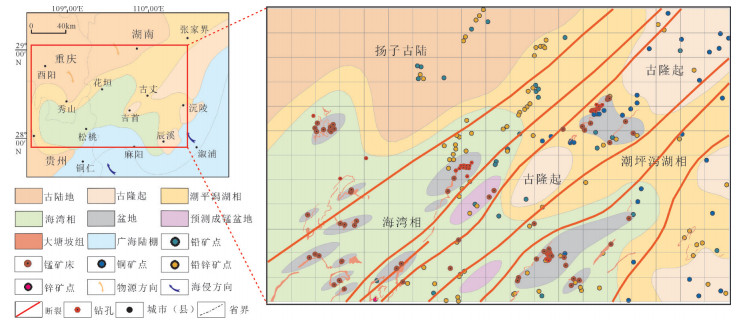
 下载:
下载:
